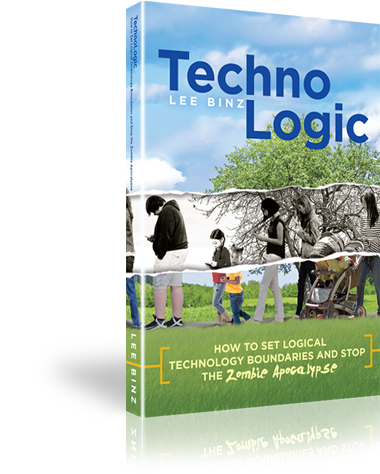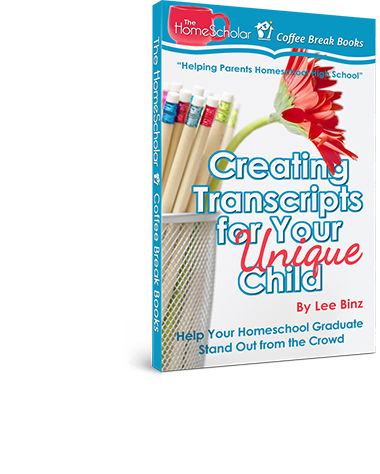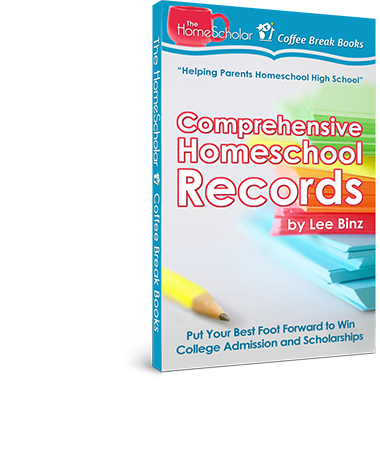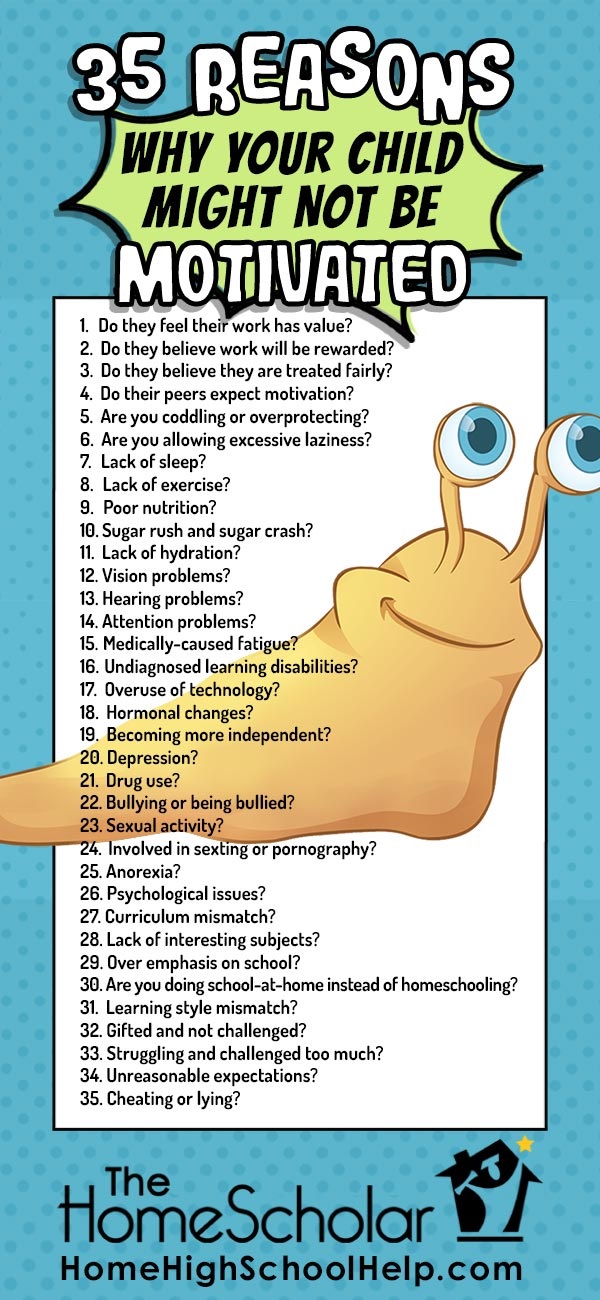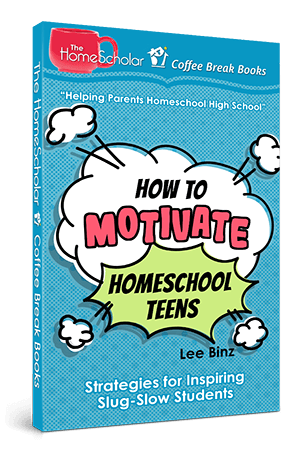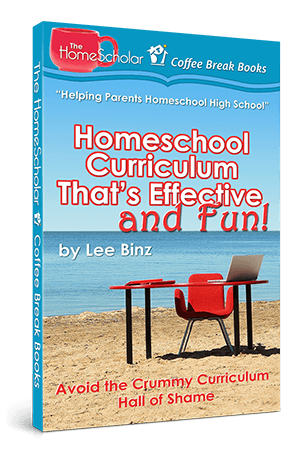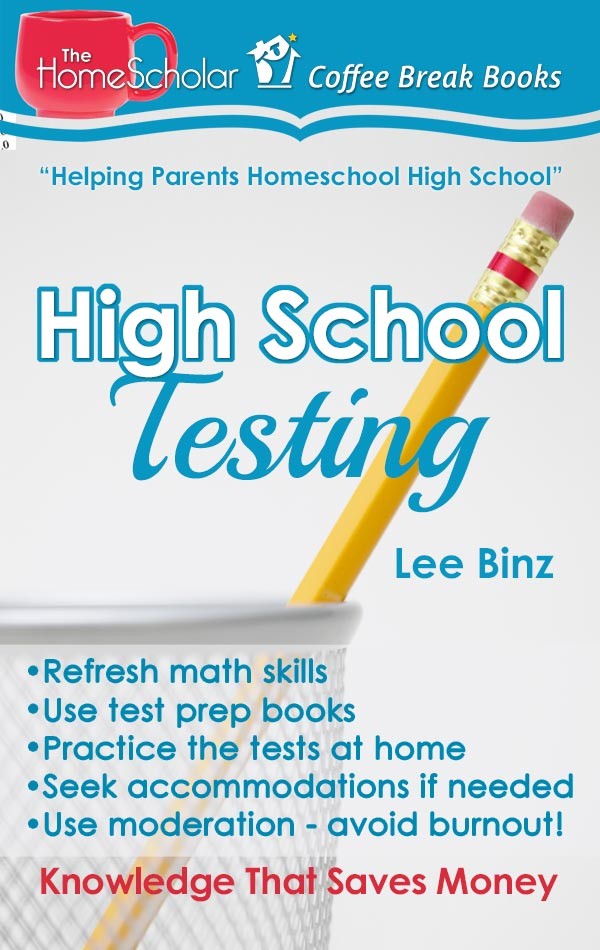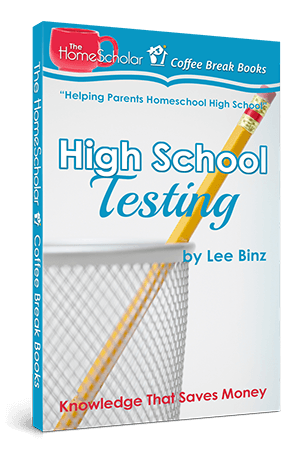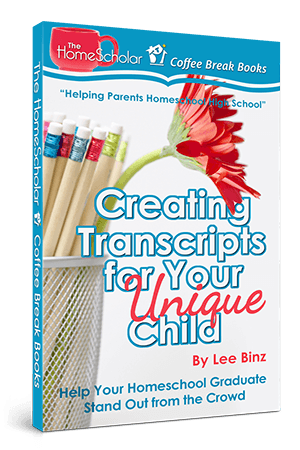— Brows through
My Books
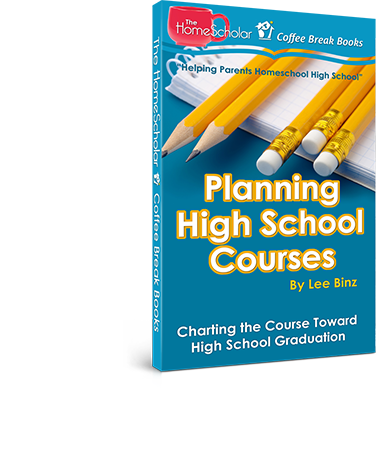
Charting the Course Toward High School Graduation
- Chart Your Child’s Course to Success
- Be Confident You’re Covering the Essential High School Classes
Price:
- Paperback: $7.95
- Kindle: $4.49
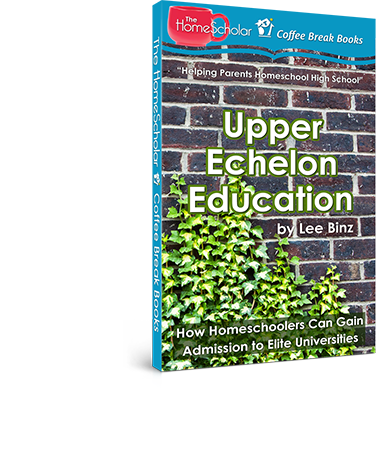
How Homeschoolers Can Gain Admission to Elite Universities
- Homeschoolers Can Go to Harvard Too!
- Help Your Child Prepare for Elite Admissions
Price:
- Paperback: $7.95
- Kindle: $4.49

How to Successfully Launch Adult Children (or Die Trying)
- Launching Teens Can Be a Roller-Coaster of Emotions!
- Be Free from the Burden of Hanging On and the Fear of Letting Go!
Price:
- Paperback: $7.95
- Kindle: $4.49

Homeschool Secrets to Getting Ready, Getting In and Getting Paid
- College Admission and Scholarships Made Easy and Fun? Inconceivable!
- Learn Secrets and Tips from America’s Top Expert in Homeschooling High School!
- Read an Excerpt
Price:
- Paperback: $7.95
- Kindle: $4.49
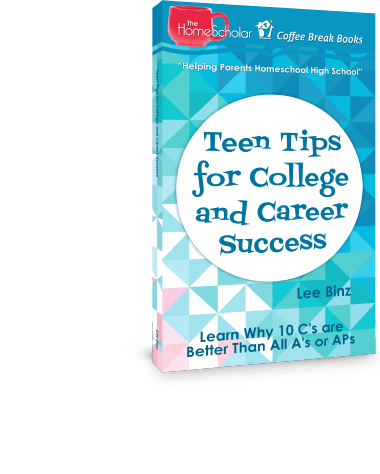
Learn Why 10 C’s are Better Than All A’s or APs
- Practical Advice for Teens to Thrive in College and Career!
- Graduation is Just the Start of Your Next Great Adventure!
Price:
- Paperback: $7.95
- Kindle: $4.49
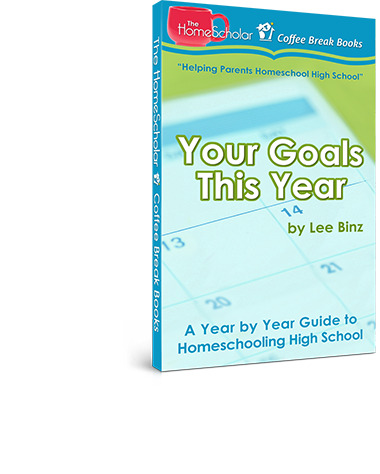
A Year-by-Year Guide to Homeschooling High School
- Spectacular Homeschool Success is Within Your Reach!
- Parents – Learn How Preparation Prevents Panic!
Price:
- Paperback: $7.95
- Kindle: $4.49

Homeschool Secrets for Success
- Take Your Homeschooling to a New Level!
- Gifted Strategies That Help Every Homeschooler!
Price:
- Paperback: $7.95
- Kindle: $4.49
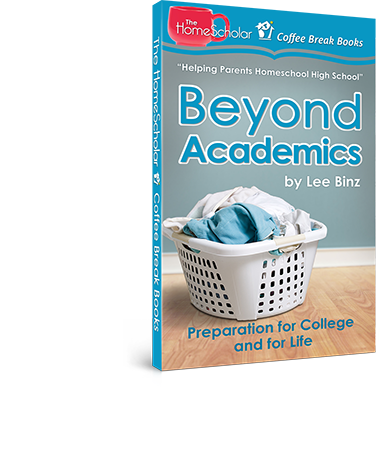
Preparation for College and for Life
- Train Your Children to Succeed in Life!
- Homeschool Secrets to Help Your Children become Thriving, Successful Adults
Price:
- Paperback: $7.95
- Kindle: $4.49
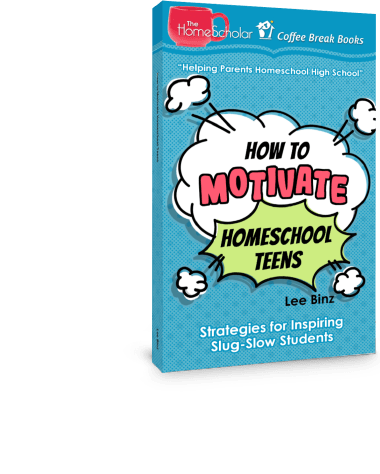
Strategies for Inspiring Slug-Slow Students
- Need to Light a Fire Under Your Unmotivated Teen?
- Learn Expert Secrets for Unlocking the Potential of your Homeschool Student!
Price:
- Paperback: $7.95
- Kindle: $4.49
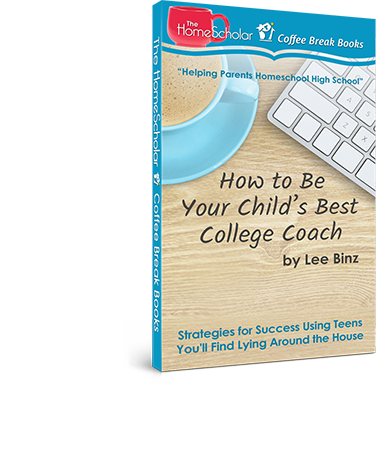
Strategies for Success Using Teens You’ll Find Lying Around the House
- High School Graduation Isn’t the Finish Line!
- Get Expert Help for Launching Your Child Into College and Career Success!
Price:
- Paperback: $7.95
- Kindle: $4.49
Clients Reviews
Thank you so much Lee!!!! I have loved all of the webinars I have watched and really appreciate the ...Read More

Tia in Indiana
Tia in Indiana
Thank you so much Lee!!!! I have loved all of the webinars I have watched and really appreciate the workbooks! This has been my first year homeschooling. I have a son in 9th grade and his sister will join him next year. A lot of people thought we were crazy for starting homeschooling in high school, but with the help of fellow homeschoolers and your wonderful resources (recommended to me a friend), we have survived our first year!!! Thanks for all of your help!

Tia in Indiana
I want to highly recommend Lee's services to anyone who has questions about the high school years! I...Read More

Lisa in Florida
Lisa in Florida
I want to highly recommend Lee's services to anyone who has questions about the high school years! I had a consultation with her yesterday and it was so helpful and amazing to watch the transcript fill before my very eyes. I think as homeschoolers we can be VERY critical of our little schools and I didn't even realize how much was learned last year. Lee's service is truly a blessing and her rates are very reasonable! I will be using her service again next year and probably every year until both of my older kids are graduated.

Lisa in Florida
You can count me as a completely satisfied customer. The Total Transcript Solution made the proces...Read More

Karen in Texas
Karen in Texas
You can count me as a completely satisfied customer. The Total Transcript Solution made the process a pleasure. Our transcript was a wonderful summary of the rich educational experience a home school education can provide. We translated my son’s home school experience into the language schools can understand, and obviously love!

Karen in Texas
Thank you for your educational website. The Total Transcript Solution has been very helpful! In the ...Read More

Allyson in Ontario
Allyson in Ontario
Thank you for your educational website. The Total Transcript Solution has been very helpful! In the last month -- since we found your site -- we have been making changes regarding our record keeping etc. Your other articles have also been beneficial in the planning for future courses, CLEPS and SAT preparation, etc. Thank you for the work that you have done in assisting families in their desire to homeschool high school. Both Jonathan and I have been raving about your website! He is a public school teacher (a fantastic one!) and has been sharing your website with his colleagues - he is enjoying his copy of essay topics. I have shared your site with other homeschool parents and they have also been extremely impressed with your vast catalogue of information. We will be sure to add your website to our handouts when we speak at homeschool events up here in Ontario. I look forward to speaking with you in the future. Wishing you continued success. A new fan!

Allyson in Ontario
Setting the Records Straight
https://youtu.be/nTxg1EYuJN4
How to Craft Homeschool Transcripts and Course Descriptions for College Admission and Scholarships
- Create Beautiful, Professional Homeschool Records to Save and Earn BIG Money!!
- Give Your Homeschooler the Advantage in the High Stakes College Admission Sweepstakes!
- Read an Excerpt
Price:
- Paperback: $24.95
- Kindle: $9.99
GIFTED EDUCATION STRATEGIES FOR EVERY CHILD
https://youtu.be/PpDi5aLbO44
Homeschool Secrets for Success
- Take Your Homeschooling to a New Level!
- Gifted Strategies That Help Every Homeschooler!
Price:
- Paperback: $7.95
- Kindle: $4.49
YOUR GOALS THIS YEAR
https://youtu.be/pmUf7FlmYG4
A Year-by-Year Guide to Homeschooling High School
- Spectacular Homeschool Success is Within Your Reach!
- Parents – Learn How Preparation Prevents Panic!
Price:
- Paperback: $7.95
- Kindle: $4.49
TEEN TIPS FOR COLLEGE AND CAREER SUCCESS
https://youtu.be/CC9qDQpNhw8
Learn Why 10 C’s are Better Than All A’s or APs
- Practical Advice for Teens to Thrive in College and Career!
- Graduation is Just the Start of Your Next Great Adventure!
Price:
- Paperback: $7.95
- Kindle: $4.49
THE HOMESCHOLAR GUIDE TO COLLEGE ADMISSION AND SCHOLARSHIPS
https://youtu.be/iKctuuvCf-g
Homeschool Secrets to Getting Ready, Getting In and Getting Paid
- College Admission and Scholarships Made Easy and Fun? Inconceivable!
- Learn Secrets and Tips from America’s Top Expert in Homeschooling High School!
- Read an Excerpt
Price:
- Paperback: $7.95
- Kindle: $4.49
LETTING GO AFTER HOMESCHOOLING HIGH SCHOOL
https://youtu.be/S5DrHBMkDSQ
How to Successfully Launch Adult Children (or Die Trying)
- Launching Teens Can Be a Roller-Coaster of Emotions!
- Be Free from the Burden of Hanging On and the Fear of Letting Go!
Price:
- Paperback: $7.95
- Kindle: $4.49
UPPER ECHELON EDUCATION
https://youtu.be/LxrGV_TumVU
How Homeschoolers Can Gain Admission to Elite Universities
- Homeschoolers Can Go to Harvard Too!
- Help Your Child Prepare for Elite Admissions
Price:
- Paperback: $7.95
- Kindle: $4.49
PLANNING HIGH SCHOOL COURSES
https://youtu.be/4RB4PNY03QU
Charting the Course Toward High School Graduation
- Chart Your Child’s Course to Success
- Be Confident You’re Covering the Essential High School Classes
Price:
- Paperback: $7.95
- Kindle: $4.49

[Book Excerpt] How to Motivate Homeschool Teens
~ A word from our founder, The HomeScholar Emeritus, Lee Binz ~
One mom jokingly told me that her son’s spirit animal was a sloth. We had a good giggle over that one, because I remember what it’s like to try to motivate homeschool teens. And frankly, misery loves company!
Misery also craves solutions. That’s where my book comes in: How to Motivate Homeschool Teens: Strategies for Inspiring Slug-Slow Students. I am so pleased that Andrew Pudewa from the Institute for Excellence in Writing joined me to contribute a couple of chapters! We teamed up to help you successfully recognize, diagnose, and solve this most common of all teenage issues. I hope you enjoy this excerpt. If you want to read more, you can purchase a copy in print or Kindle version on Amazon.
Chapter 1
It can happen overnight. One day your child is pleasant, cooperative, and enthusiastic about learning; the next day, they aren’t. This can happen with girls or boys; sometimes it happens at a certain age. Don’t feel as if you’ve done something wrong, because it’s common.
You might identify the problem when your child starts to resemble a slug. Slugs are soft, gooey, and malleable; you can wad them into your fist. Similarly, your child is not moving, even though they might still be sweet and pleasant.
Or you might have a snail — soft and gooey on the inside, but hard on the outside. They have a real edge to them that’s impenetrable. There are many kids like this who are not letting their parents into their lives.
You might find your teen is more like the sloth — the one that hangs around all day moving in slow motion. They don’t do anything other than eat.
Or there’s the tortoise. This kind of teen is most notable when you have a younger child who seems like the hare in comparison. Although the tortoise is slow, they can win the race if they plod ahead.
What kind of behaviors does your teen exhibit? Often, they are slow as molasses or do the bare minimum. Sometimes they’re couch potatoes, uninterested in everything.
Sometimes it is just a phase, as if the kids are checking in to see who’s the boss and what matters to their mom and dad. When that is the case, the solution is to wait until the phase is over. But that can be difficult.
Motivation problems can last a couple weeks, until the child or the parent figures out what adjustments need to be made. Or a lack of motivation can last for months, years, or until the child finds something that sparks their interest.
When the child has a lack of motivation but a good attitude, it can be difficult to endure. You’ve raised them right and they have a great attitude, but you’re baffled that they don’t feel like doing anything. Frankly, this was the trouble we had in our home.
Or your child might have a lack of motivation and a bad attitude. Even in good families, a child can become slightly rebellious. Your child could be aggressively obnoxious about doing what they need to do.
A lack of motivation with behavioral problems might need to be addressed separately from school when it becomes difficult to manage. It might only be a phase, or it could happen randomly — a few days each month or only a certain time of year. Or this lack of motivation could become pervasive and last for months or years.
However it manifests in your home, know that you are not alone. Motivation problems can happen, even in happy, loving families. Your child could be a perfectionist who suddenly becomes a couch potato. One of my friends was devastated when her daughter changed like this at the age of 14. Her daughter had always been a driven, musical perfectionist; suddenly, she wasn’t interested in the piano, flute, or music at all anymore.
My friend was worried about her daughter’s uncharacteristic lack of motivation. She was sitting around on the couch much of the day. Finally, her daughter happened to pick up a guitar for the first time. A few months later, her daughter had practiced the guitar so well that she started volunteering as a worship leader at church.
One of my clients was concerned about homeschooling high school because her son was sitting on the couch all day eating ice cream. The entire time I spent at her house, her child sat on the couch eating ice cream and playing video games. I saw this client a few months later and her son had completely turned around; she had forced him to try and find activities he might be interested in and one of them was a class in speech and debate at a homeschool co-op.
He discovered speech and debate as well as politics and started going 100 percent full-speed ahead in their homeschool. He still was not motivated to do his math work, but 90 percent of the rest of school was taken care of by speech and debate and motivation wasn’t a problem anymore.
We had our own issues, especially with my oldest child (who does have perfectionist tendencies and tends to be slightly sloth-like). He wanted to do everything perfectly and took his own sweet time. The love he had for chess seemed to get in his way because he played chess constantly.
Chess seemed like a waste of time since he was sitting on the couch most of the day. He played chess and read chess books for hours on end. It wasn’t until much later that I realized he was working on his area of specialization and the logical thinking would one day help him become an engineer working on computer science.
Remember that you are not alone. Many parents must endure their teens’ motivation problems and it can happen in a variety of different ways. It’s not your fault.
How to Motivate Homeschool Teens is one of my Coffee Break Books. What are Coffee Break Books? These are books designed for YOU – a busy homeschool parent feeling frustrated by something, and needing information NOW – all put together in an easy to read, short, simple format. Coffee Break Books are perfect for overwhelmed, sleep-deprived moms with a baby on their hip. Simple, large font makes them easy to read even when distracted or pulled in a million directions. They are designed to help parents tackle just ONE issue of homeschooling during just ONE coffee break! Each book combines a practical and friendly approach with detailed, easy-to-digest information. Never overwhelming, always accessible and manageable, each book in the series will give you the tools you need to tackle the tasks of homeschooling high school, one warm sip at a time.
Learn more in my review below!
This is a chapter from my book, How to Motivate Homeschool Teens: Strategies for Inspiring Slug-Slow Students. You can purchase a copy in print or Kindle version on Amazon.

[Book Excerpt] Gifted Education Strategies for Every Child
~ A word from our founder, The HomeScholar Emeritus, Lee Binz ~
This is a chapter from my book, Gifted Education Strategies for Every Child: Homeschool Secrets for Success. You can purchase a copy in print or Kindle version on Amazon.
Chapter 1
As a parent, you have what it takes to teach your gifted child, because you are the love giver and not only a care giver. You are the person chosen and created for this job, in the same way your child was chosen and created to be placed in your family. When my son Kevin was born and my midwife handed him to me, she gave me the best advice I have ever received and the only advice I needed for being a parent. She said, “Know your child and trust yourself.”
How Do You Know They’re Gifted?
In general, gifted children learn more, faster, at an earlier age. They remember more, understand abstract concepts (and understand them earlier), have passionate interests, and can do multiple tasks at once and do them well.
Expert definitions vary widely. One expert says gifted children have an I.Q. of 130 or more. Another expert says those who score in the top 2.5 percent on standardized tests are gifted. Others say gifted children are two grade levels above their age group and capable of high performance. The problem with these evaluation methods is that some gifted kids don’t test well or are not compliant.
Of course, gifted doesn’t mean they’re smarter than everyone else. There will always be others who are smarter, if not across the board then at least in one subject. For instance, your child may be gifted in piano but there will be others who play the cello or dance more brilliantly. There’s always someone else smarter.
In the end, definitions don’t change anything. They won’t change your child and may not change what matters. Your job is to decide whether the label of giftedness is important for your child and their goals, and go from there.
Acceleration—Work Faster
What exactly should a homeschool parent do differently to teach a gifted child? There are many techniques you can use. The first strategy I find useful is called “acceleration,” which means allowing your child to work faster than a curriculum usually progresses. Using acceleration, you can spend less time on a subject because your student learns the material in far less time than is typical.
With acceleration, you need to let go of the whole teaching concept because your job is not to teach your child. Your job is to teach your child to learn. There are, in fact, times when you don’t need to teach.
Your child might already know the work, they might have learned it by osmosis, or they picked it up so quickly you don’t need to teach it. Assess your child’s level first, beginning the curriculum at the point where they can learn something new. In this way, you allow them to learn at their own level, removing artificial barriers that dictate how much they can learn and how quickly. Pre-test your child and simply skip past what they already know in the curriculum. If your child doesn’t need fabulous supplementary activities, it’s also okay to skip them, as long as they’re learning what they need to learn.
At high school level, remember that you can give your child high school credit as soon as they finish a standard curriculum. You don’t have to make sure they sit in front of you for 150 hours before awarding credit. As soon as they’re done with the curriculum and know the material, go ahead and give them high school credit.
When you don’t accelerate, instead forcing your gifted child to work at the standard pace, your child can become bored. When parents say their teen is not motivated, hates school, or is bored, it’s often because they are being forced to work at too slow a pace.
Gifted Educations Strategies for Every Child is one of my Coffee Break Books. What are Coffee Break Books? These are books designed for YOU – a busy homeschool parent feeling frustrated by something, and needing information NOW – all put together in an easy-to-read, short, simple format. Coffee Break Books are perfect for overwhelmed, sleep-deprived moms with a baby on their hip. Simple, large font makes them easy to read even when distracted or pulled in a million directions. They are designed to help parents tackle just ONE issue of homeschooling during just ONE coffee break! Each book combines a practical and friendly approach with detailed, easy-to-digest information. Never overwhelming, always accessible and manageable, each book in the series will give you the tools you need to tackle the tasks of homeschooling high school, one warm sip at a time.
Learn more in my video review below!
This is a selection from my book, Gifted Education Strategies for Every Child. If you enjoyed the post and want to learn more about gifted education strategies for your homeschool students, you can buy the book on Amazon in both paperback and Kindle versions!

[Book Excerpt] Finding the Faith to Homeschool High School
In this post, I share a selection from my book:
Finding the Faith to Homeschool High School
When you choose to homeschool high school, sometimes the thing separating success from failure is faith and a friend. I know it can be so challenging. I also know that sharing scripture with a friend can really help.
I have a 5-minute weekly devotional for homeschool moms to encourage you. I’m not a Bible scholar, I’m The HomeScholar. My area of expertise is homeschooling. I also know that searching the scriptures helped me cope with the daily challenges. While I’m not a theologian, I am a mom who loves my Bible. I’d love to encourage you to meditate on God’s word too.
In Finding the Faith to Homeschool High School, we can share underlined verses together over coffee. It’s not a dissertation about heavy theological concepts. This book is about you and I sharing “What did you read in God’s word today?” Imagine sitting across the table at your favorite coffee shop, sharing struggles and scriptures with each other.
Unlike other homeschool books which cover a broad range of challenges, this 52-week Christian devotional for homeschool moms covers the challenges we face while homeschooling high school. Gain a refreshing perspective on “homeschooling from a place of rest” that will support and encourage you along the way. You will have a new scripture and lesson to meditate on each week throughout the year.
Homeschool Moms Love This Weekly Devotional for Women!
Jennifer was digging through piles of homeschool records and found my book, Finding the Faith to Homeschool High School. She went from panic to peace in 20 pages, saying…
“I uncovered a pile of my school-related record keeping items and discovered your book Finding the Faith to Homeschool High School. I randomly opened to page 85 and read about The Great Pause. Thank you for writing this book. I read about 20 pages, and I felt like you were exactly describing my feelings, my heart, my concerns, my worries, etc … and the peace I felt after realizing this isn’t just my story, my kid, my fears … the peace was solid. Thank you for writing this book!! I appreciate you! And that book is just what I need right now!” – Jennifer in Oregon
How Would “Finding the Faith” Weekly Devotional Be Encouraging to You?
“Finding the Faith to Homeschool High School is like having a dear friend provide heart-felt reassurance that is invaluable when the struggles of self-doubt arise. This book is filled with weekly scripture and encouragements for the homeschool mom, providing a message of hope and guidance as you go through your week.” — Merri Cue, Homeschool Mom of six, President of Frisco HIS Homeschool Support Group, Texas
“In her conversational style, Lee has driven right down to the secret places in my homeschool mom’s heart and set up a coffee shop for a visit. What an encouragement to read Finding the Faith and seeing that we all have struggles, yet we all can make it.” — Renita Terrell, Homeschool Mom of four, Kansas
“You addressed very practical issues with scriptural encouragement. As are all of your materials, it was down-to-earth and practical, but with encouragement from God’s word to help us to put things in perspective and press on with courage and confidence.” — Ann Sadoian, Homeschool Mom of three, Connecticut
“It is as though a friend has sat down beside you to whisper needed encouragement into your tired, anxious ears. Having second thoughts about your calling to educate your children outside of the school context? Lee’s beautiful weekly devotional will turn your heart back towards God and your children.” — Dorothy Murphy, Home Educating Parent and Exam Tutor, United Kingdom
“Lee Binz has delivered up a wonderful book full of advice that I wish I had heard when I was just starting out, full of discouragement and questioning if I made the right choice. Fast-forward to high school, when the doubt became even worse, and this would have helped ease my uncertainties.” — Lisa Berry, Homeschool Mom to three boys, Maine
Get your copy of Finding the Faith to Homeschool High School and go from panic to peace!
The Lord created your child for your family. Before this child was even born, their entire life span was known to God. All of the days for your child are already ordained. You simply can’t do anything so bad that it will change those plans. God is in control, not us! This encouraging weekly devotional will give dozens of scriptural reasons that will strengthen you and encourage you throughout the coming year. My goal is for you to homeschool with confidence!

[Book Excerpt] Homeschool Curriculum That’s Effective and Fun!
~ A word from our founder, The HomeScholar Emeritus, Lee Binz ~
This is a chapter from my book, Homeschool Curriculum That’s Effective and Fun: Avoid the Crummy Curriculum Hall of Shame! You can get your own copy in print or Kindle version here.
Stick with What Works
The most important general strategy for choosing curriculum is to stick with the curriculum that works. When you identify something that works (whether it’s baking brownies at the end of a hard workday or sipping a latte to get started in the morning), it’s what you need to do to survive. A curriculum is like that too; use what works.
If your homeschool curriculum has been working all along, keep using it. Stick with it and don’t make a change. No matter how beautiful the green grass looks on the other side of the fence, you have no guarantee that shiny new curriculum is going to work. All you know for sure is that your curriculum is working for your child. Even though another curriculum seems to work great for your best friend’s kids, that doesn’t mean it will work for you.
A second important strategy is to use the method that works. If your learning style or homeschooling style works, keep using it. If you’re doing great with delight directed learning, stick with it. If you use the school-at-home approach and your kid thrives on textbooks and workbooks, then keep at it. The flip side of this is also true. If the approach you are taking is not working, then stop using it and either go back to what you used before or make a change. Look for a curriculum provider that has worked for you in the past.
I personally used Sonlight curriculum. When they recommended a resource, I knew there was a high likelihood it would work for us, because everything else they recommended was successful. If you find something that works, keep using it—whether it’s a curriculum, a style, or a provider, keep using it. (If all else fails, grab some chocolate, because chocolate solves all of life’s problems.)
Use a Homeschool Curriculum
One of the most important guidelines for choosing a curriculum is to choose a homeschool curriculum whenever possible. A homeschool curriculum is different from a public school curriculum. It assumes the teacher knows nothing about the subject. If you choose a public school curriculum, it will assume you have a degree in the subject to teach it. Homeschool parents don’t typically know all their subjects thoroughly in advance, and a homeschool curriculum makes allowances for this. A homeschool curriculum is also intended to work well at home rather than in a group setting with group questions and group activities.
When my sons were in high school, I was nervous about teaching them Latin; I knew nothing about Latin. I had one Latin book I borrowed from a friend, downloaded a sample from another Latin curriculum, and compared the two of them. I was a bit shocked when I looked at my friend’s book; after looking at the first page, I didn’t have a clue what it was talking about! If I’d used that book, I wouldn’t have known how to instruct my children. It was intended for a public school setting and assumed I knew Latin.
In contrast, the first chapter of the homeschool Latin program said, “Copy this information into your own notebook so you will learn what Latin is.” So, that’s what we did. This book gave specific directions about what to do each day, and I can say with confidence that my sons learned Latin. Make sure you use a homeschool curriculum and not a curriculum intended for a public school.
As homeschoolers, we try to save money, and sometimes we’re so desperate that we’ll grab a used textbook from a public school. Sometimes this won’t help in the long run. It may not even save you money if the book gets so frustrating that your child ends up hating the subject. Think carefully when you choose.
As a homeschool teacher, you don’t need to have a degree to teach a subject. One of the goals for homeschooling is to teach your child how to learn. When you use a homeschool curriculum, make sure it’s one that promotes self-teaching, not so you teach yourself, so your child teaches themselves. Children need to learn how to learn; it’s one of the most important skills you will teach your child, both for college and for life.
Adults need to teach themselves all the time. I had to teach myself how to use the computer (but my husband helped!). I taught myself how to use QuickBooks. Self-teaching is what adults do in day-to-day life. Children will grow up and become adults, and they need to teach themselves. When you use a self-teaching curriculum, you’re training your child to become a better adult—it’s an important skill for adulthood.
In the younger years, parents are teachers. We taught our children how to write in cursive, multiply, and understand historical events. When children become teenagers, they start self-teaching more and more. That’s when the parent’s role changes from teacher to project manager—the overseer, the person who simply makes sure it’s done and done correctly but doesn’t do the work themselves.
This is one of the reasons why you don’t have to learn Latin or physics to teach the subject. You only need to be the project manager for your child learning Latin or physics.
Public schools don’t usually have the benefit of using a homeschool curriculum. If you feel inadequate, simply remember that some public school teachers don’t even have a degree. All teachers struggle with the same challenges. Sometimes even gifted teachers with a degree have difficulty teaching when forced to use a rotten curriculum. As a homeschool parent, you get to choose a curriculum you feel comfortable using, regardless of whether you have a degree in the subject. You can also use a curriculum that is appropriate for your children and make as many modifications as needed as time goes on. What freedom!
Homeschool Curriculum That’s Effective and Fun is one of my Coffee Break Books. What are Coffee Break Books? These are books designed for YOU—a busy homeschool parent feeling frustrated by something, and needing information NOW—all put together in an easy-to-read, short, simple format. Coffee Break Books are perfect for overwhelmed, sleep-deprived moms with a baby on their hip. Simple, large font makes them easy to read even when distracted or pulled in a million directions. They are designed to help parents tackle just ONE issue of homeschooling during just ONE coffee break! Each book combines a practical and friendly approach with detailed, easy-to-digest information. Never overwhelming, always accessible and manageable, each book in the series will give you the tools you need to tackle the tasks of homeschooling high school, one warm sip at a time.
Learn more about fun and effective homeschool curriculum in my video review below!
This is a chapter from my book, Homeschool Curriculum That’s Effective and Fun: Avoid the Crummy Curriculum Hall of Shame! You can get your own copy in print or Kindle version here.

[Book Excerpt] High School Testing
~ A word from our founder, The HomeScholar Emeritus, Lee Binz ~
This is a chapter from my book, High School Testing: Knowledge That Saves Money. You can purchase a copy in print or Kindle version on Amazon.
Study for the SAT®
Studying for a college entrance exam is worthwhile for most college-bound high school students. It’s not a waste of time! Research has shown that preparation can increase SAT® scores by 100 points. Better SAT® scores can increase your child’s chances of earning college admission and academic scholarships. Making test preparation a regular part of your high school experience will make it much easier for your student to succeed. Public school students may have trouble finding time to prepare for the test, but it can be a part of your homeschooler’s total educational experience.
Like many homeschool parents, I understood that studying for the SAT® test was necessary for college admission and financial aid but was frustrated that I had to “teach to the test.” My teenagers were also resistant. But the tests measure basic skills and of all the things I wanted my children to learn, reading, writing, and math were high on the priority list. Now that we are on the other side, we can all see the benefits of preparation!
- High scores helped my children earn great scholarships.
- They learned important essay writing skills.
- They mastered math concepts from basic to advanced.
- They gained confidence in their test-taking abilities.
The Basics
The SAT® is a standardized college entrance exam with two sections that measure evidence-based reading and writing, and math skills. Each section is graded on a 200-800 scale. For each section, a grade of 500 is average, 600 is good, 700 is great, and 800 is perfect. Because there are two sections, a perfect score on the SAT® is 1600. Prior to the newly designed SAT®, a perfect score was 2400 because there were three sections. The test takes three hours, plus 50 minutes for the optional essay section, and is given at local high schools and some colleges. For more information, go to www.collegeboard.com.
Refreshing math skills can be helpful for a struggling student who might benefit from a regular review of concepts. Math review will also help an advanced student, who may not have gone over beginning concepts for many years. The reading section includes vocabulary students need to know to succeed in college. Instead of buying a vocabulary curriculum, you can use SAT® preparation for your homeschool vocabulary studies.
I must confess that the essay is my favorite part of the test. Essay writing is crucial to success in college. My youngest son thanked me for teaching him how to write a typical test essay.
Tools to Prepare
Before high school begins, you can prepare for the SAT® by providing a quality education that includes reading, writing, and arithmetic. Penmanship is important as well, since part of the SAT® is an optional hand-written essay seen by colleges. Homeschooling parents have the advantage on the SAT® test when they provide a quality, well-rounded education for their child.
But how does a high school student prepare for such a test? There are some great test prep books, but I prefer the ones from The Princeton Review. I feel they have a youthful, conversational style that appeals to teenagers more than the dry, “business only” approach of other books. I used the book, Cracking the SAT® by The Princeton Review. It has a short, easy to understand explanation of the test, and includes four complete exams. All the answers provide clear explanations.
In our homeschool, we completed one section of one practice test at a time. Each section is 25 minutes long. We used a timer to simulate a real testing environment. After completing a section, my children corrected their tests by themselves, and looked over the explanation of each wrong answer.
If they still had questions, my husband went over the explanation with them. For more practice, check out 500+ Practice Questions for the New SAT® by The Princeton Review. It has a section on what to expect in the new SAT® along with many practice questions. The focus of this book is only sample questions. It gives clear, concise answers and explanations for every problem.
For students who need more essay writing practice, check out the AP® English Language and Composition free response questions; the prompts make perfect practice for the SAT® essay section. You can find sample free response questions on the College Board’s AP® English Language and Composition page. In fact, the AP® English Language and Composition exam makes a great ACT®/SAT® prep course when taken in junior year.
For more SAT® math, reading, writing, and essay practice, you can also visit the Khan Academy website at khanacademy.org/sat. In cooperation with the College Board, Khan Academy offers free information, practice tests, quizzes, video lessons, and hints.
Other kinds of test preparation can also increase scores and yield great dividends. Some students learn better without textbooks. For the reading and writing section, you can prepare your child using a “real books” approach. Reading quality literature is the best preparation.
Many test preparation companies offer classic literature that highlights SAT® vocabulary words. Kaplan publishes a series of books called SAT® Score-Raising Classics. They are books such as Frankenstein, Wuthering Heights, and The Scarlet Letter with the text on one side of the page and vocabulary words in bold print. On the other side of the page, each word in bold is defined in simple terms. We used these books as a part of our regular curriculum choices, and they doubled as SAT® preparation. I read aloud, and my children read the vocabulary definitions over my shoulder as we went along.
Auditory learners might prefer the Verbal Advantage program for vocabulary development, with its audio CDs and CD-ROM guidebooks. There are also SAT® prep video tutorials available through Standard Deviants (www.standarddeviants.com) and The Teaching Company that can provide vocabulary and math review for visual learners.
Practice Might Make Perfect
You can enroll your child in a formal SAT® class at home, using a variety of online courses through test preparation companies such as the College Board, Kaplan, or The Princeton Review. This may be a good option for a student who is a visual or auditory learner, or a student willing to do anything if it’s on the computer. Your child can also take classes through a co-op (usually inexpensive) or a private course (usually pricey).
Our local library offered a practice test twice a year, through The Princeton Review. It was the most realistic practice we found, because it was a real test in a real test situation, graded so we had an objective score for each child. The SAT® is such a long test that we were thankful our kids could try it in a safe environment before they took it for real.
Studying for the SAT® can benefit your homeschool, but it’s possible to go overboard. Studying for hours a day, for weeks on end may cause burnout. The last thing you want is to frustrate your teenager so much that they hate homeschooling. You want them to learn test-taking skills and reinforce basic skills but do it with a light touch. Know your student and trust your own judgment.
Accommodations for Homeschoolers
If your child struggles with learning challenges, it may be helpful to get an official diagnosis, and then pursue accommodation on the SAT®. Accommodation requires a recent diagnosis from a doctor, and there are specific rules that must be followed.
If the essay is a stumbling block, you can also opt for the SAT® or ACT® test without the optional essay. The SAT® or ACT® work equally well for college admission. If you decide to avoid the essay, you can instead have your child take plenty of time on the college application essay, perhaps even explaining their difficulty with writing.
Look over the Dragon Naturally Speaking software to see if it can be a solution to help your child write college application essays and in other areas of school. Check the College Board Services for Students with Disabilities for more on accommodations.
High School Testing is one of my Coffee Break Books. What are Coffee Break Books? These are books designed for YOU – a busy homeschool parent feeling frustrated by something, and needing information NOW – all put together in an easy-to-read, short, simple format. Coffee Break Books are perfect for overwhelmed, sleep-deprived moms with a baby on their hip. Simple, large font makes them easy to read even when distracted or pulled in a million directions. They are designed to help parents tackle just ONE issue of homeschooling during just ONE coffee break! Each book combines a practical and friendly approach with detailed, easy-to-digest information. Never overwhelming, always accessible and manageable, each book in the series will give you the tools you need to tackle the tasks of homeschooling high school, one warm sip at a time.
Learn more about High School Testing in my video review below!
This is a chapter from my book, High School Testing: Knowledge That Saves Money. You can purchase a copy in print or Kindle version on Amazon.
SAT® and AP® are trademarks owned by the College Board, which is not affiliated with and does not endorse this blog post or The HomeScholar, LLC.

[Book Excerpt] Setting the Records Straight
This is a chapter from my book, Setting the Records Straight: How to Craft Homeschool Transcripts and Course Descriptions for College Admission and Scholarships. You can purchase a copy in print or Kindle version on Amazon.
The Love Languages of College
A homeschool transcript is the “love language” of colleges. A transcript is your homeschool experience translated into words and numbers that colleges understand. When homeschoolers talk among themselves, they may say, “Today we had so much fun! We had a great lesson, and combined it with a wonderful hands-on experience, and then read a book in the park together. It was wonderful!” A transcript is just translating these conversations into words like “course titles” and numbers like “grades and credits.”
You don’t have to change the way that you homeschool to make it fit a transcript! It goes the other way. You take what you are already doing in your homeschool – what is already working – and create the words and numbers that colleges understand. What you are doing is taking your wonderful educational experiences and translating them into “college-ese.” Document your homeschool “as-is.”
Parent-made homeschool transcripts work! My students were admitted to all four colleges they applied to, and they were given fabulous scholarships from each one. In fact, both of my sons were given four-year full-tuition scholarships to their first choice university. They applied using my homeschool transcript with my own “mommy grades.” You don’t need to worry about accreditation or fancy paper or getting software to do it the right way. You can make your transcript the right way just by doing it yourself.
Setting the Records Straight
Creating an impressive homeschool transcript that colleges will love is easy and completely possible. The best thing about transcripts is that there is really no right or wrong way to do them. The process is more of an art than a science. There are so many ways you can make a transcript, and each way is OK! There is freedom in making your homeschool transcript! My transcripts were nothing particularly fancy. They were created as Word documents on my home computer and printed on regular printer paper. And still, the colleges LOVED THEM!
Why would you make your own homeschool transcript? By making your own, you retain your status as an independent homeschooler. That gives you complete control over your student’s academic record, and you can make sure that it truly represents who they are and what they know. A homeschool transcript can include all your academic experiences.
Your transcript can also save you money if your children go to college. Properly documented transcripts can earn big scholarships. Creating your own transcript is a very important piece of documentation that colleges need from all applicants. Your transcript is as official as your homeschool. Don’t be shy about it! These days, almost every college will accept a homeschool transcript made by a parent. Homeschooling is a very popular educational option, and colleges want our students!
Don’t worry about whether you can create a winning homeschool transcript. I’m living proof that you can! There is no reason to feel overwhelmed. You can learn how to make an AMAZING transcript that will perfectly represent your student and your homeschool.
From the Back Cover
What keeps you up at night? Transcripts and credits? Course descriptions and grading criteria? Grade point averages? Great News! You can prepare homeschool records that impress colleges! This book provides the information and confidence you need. Setting the Records Straight is a complete resource for homeschool records! Easy to read and logically organized, it provides plenty of examples from real homeschool families. If you have ever longed for a visual example of successful homeschool documentation, this is the book for you.
“This is a must-read for those of us planning to homeschool through high school. If you are thinking about high school records, this book will answer all your questions!”
~ Heidi Strawser, The Old Schoolhouse Magazine
“This book was the most VALUABLE tool I’ve seen on the nuts and bolts of transcripts and course descriptions! You literally answered EVERY question that came to mind.”
~ Lori MacMath, Heart of the Matter Magazine
“I was very, very impressed. I have already recommended it to others. It really is amazing information… well organized, well written, and professionally put together.”
~ Robin E. Williams, Homeschooling mother of 5
“With humor, understanding, and simple step-by-step instructions, you’ll be encouraged and equipped to consolidate your educational experiences with excellence.”
~ Ann Dunagan, Author of The Mission-Minded Family, Homeschooling mother of 7
“Your transcripts and records were the best organized and documented I have seen” – Bryan Jones, Associate Director of Admissions, Seattle Pacific University
Setting the Records Straight is available in Kindle or paperback versions on Amazon:
Learn more in my review below!
This is a chapter from my book, Setting the Records Straight: How to Craft Homeschool Transcripts and Course Descriptions for College Admission and Scholarships. You can purchase a copy in print or Kindle version on Amazon.

[Book Excerpt] High School Math the Easy Way
~ A word from our founder, The HomeScholar Emeritus, Lee Binz ~
This is a chapter from my book, High School Math the Easy Way: Simple Strategies for Homeschool Parents In Over Their Heads. You can purchase a copy in print or Kindle version on Amazon.
Chapter 1
Correct Sequence
In what order do you need to teach math? It may surprise you that the order you cover math doesn’t matter as much as ensuring math is taught for four full years in high school. The high school transcript needs to include four or more credits of math. This is important because it’s required for high school graduation in every state. It’s also important because almost all colleges require four years of math. Even if your child already has four or five years of math by the time they start high school, you still want to teach four years of math while they’re in high school (at high school age).
However, this doesn’t mean your child must do four years of upper level math, including calculus. It simply means they should continue to work at their own level and keep moving forward every year. Yes, it’s wonderful to complete calculus in high school, but not everyone will get there. Not getting to calculus doesn’t mean they can’t get into college! Simply cover math every single year.
The sequence may vary. There are two ways math is usually introduced:
Algebra 1 – Geometry – Algebra 2 – Trigonometry or Pre-Calculus – Calculus
or
Algebra 1 – Algebra 2 – Geometry – Trigonometry or Pre-Calculus – Calculus
Try to get geometry completed before 11th grade if you can. Children take the PSAT®, SAT®, or the ACT® in eleventh grade, which all include geometry. If geometry is finished before 11th grade, your child will score better on these tests. I prefer the first sequence option because your child will be more likely to complete geometry before 11th grade.
Geometry is completely different than algebra, much like biology is different than chemistry. Kids who hate algebra may love geometry. Introducing geometry in the middle gives kids a break. Geometry class also has some review of Algebra 1 concepts in it. As your child balances numbers, they use some of the skills learned in Algebra 1. By completing Algebra 1 followed by geometry, your child gets a whole year of Algebra 1 practice before Algebra 2. It can help students insecure in their Algebra 1 skills to get it into their brains before they start Algebra 2.
High School Math the Easy Way is one of my Coffee Break Books. What are Coffee Break Books? These are books designed for YOU – a busy homeschool parent feeling frustrated by something, and needing information NOW – all put together in an easy-to-read, short, simple format. Coffee Break Books are perfect for overwhelmed, sleep-deprived moms with a baby on their hip. Simple, large font makes them easy to read even when distracted or pulled in a million directions. They are designed to help parents tackle just ONE issue of homeschooling during just ONE coffee break! Each book combines a practical and friendly approach with detailed, easy-to-digest information. Never overwhelming, always accessible and manageable, each book in the series will give you the tools you need to tackle the tasks of homeschooling high school, one warm sip at a time.
Learn more about High School Math the Easy Way in my video review below:
This is a chapter from my book, High School Math the Easy Way: Simple Strategies for Homeschool Parents In Over Their Heads. You can purchase a copy in print or Kindle version on Amazon.
SAT® is a trademark owned by the College Board, which is not affiliated with and does not endorse this blog post or The HomeScholar, LLC.
PSAT/NMSQT® is a registered trademark of the College Board and the National Merit Scholarship Corporation.

[Book Excerpt] Simple Science for Homeschooling High School
~ A word from our founder, The HomeScholar Emeritus, Lee Binz ~
This is a chapter from my book, Simple Science for Homeschooling High School: Because Teaching Science Isn’t Rocket Science! You can purchase a copy in print or Kindle version on Amazon.
Chapter 1
Five Reasons to Teach High School Science
Reason 1: Science is required for high school graduation.
Almost all school districts require science as part of their core curriculum. It’s a core element of graduation in many states. When you look up state requirements, make sure they are your state homeschool requirements because they may be different from state public school requirements.
Reason 2: Science is also required for college admission.
Colleges usually demand more than what is required for high school graduation. In general, as part of a college prep education, colleges look for at least three years of science with at least one lab. If you plan to teach four years of science, that’s great, you can exceed expectations. Your child can earn better scholarships by taking science every year.
Four years of high school science can be important, even for kids who have absolutely no inclination of a science-related career. It’s a good idea to include a full four years of science. It can pay off in the long run. Besides, teenagers change their minds and may someday decide on a science-intensive career. You want them to be ready!
Reason 3: High school science helps children build critical thinking skills.
Learning critical thinking through science prepares children for the ACT® and understanding science helps them better analyze data and form accurate conclusions. As adults, they will be able to think critically about news reports or studies in the paper. The thinking skills learned in high school are skills used daily. Science helps form these critical thinking skills.
For children who love science, it is equally important to study English, art, and the liberal arts. It helps them develop critical thinking skills in a different way. They need a college prep education to pull all the pieces together. People who make great scientific discoveries also have information beyond science they can bring to the forefront. They can take their acquired knowledge about the human body and other knowledge on engineering and come up with amazing new prosthetic devices.
Reason 4: Science demonstrates that children have the ability to work hard.
Colleges and employers both want people with a strong work ethic. Strong, academic subjects on your child’s transcript show they can work hard. Four years of science show that your child worked hard for four years. Your child can be successful getting into college and career because they have demonstrated hard work.
Reason 5: Science is required for STEM careers, and colleges are willing to pay for it.
STEM stands for science, technology, engineering, and math. The good news is, if your child has an aptitude in these subjects and you’re preparing your child for a STEM career, they are eligible for some fabulous scholarships. Keep an eye on the big picture; you’re investing money in science and math curriculum for good scholarships in the future.
If possible, graduate your child with a calculus and a physics class if they are looking forward to a STEM career. This isn’t always possible and it’s not mandatory (you can search for a college that doesn’t require these subjects instead). There are great jobs available for those with STEM degrees.
Teaching vs. Facilitating
You do have to cover science in your homeschool, but that doesn’t mean you must teach science. Instead, you can facilitate science. Once your children are high school age, your job will change, and you’ll become the facilitator or project-manager. You’re the one who makes sure they learn and not the one who needs to teach the entire curriculum.
What does teaching science look like at home? When I was homeschooling high school, my children read the textbook with the teacher’s manual in their hands. They worked through each lesson on their own; if they were stuck, they looked at the solution manual and compared the answers to their own work. They taught themselves through the questions and answers given in the curriculum.
When it was time for a test, I took away the solution manual and gave them the test. Because I was not perfectly prepared to teach (being a good facilitator and not a good teacher), I didn’t know what the answers had to look like, especially in physics. When marking tests, I made sure the answers looked exactly like those in the solution manual. It didn’t matter if my children claimed their answer meant the same thing—each answer had to be exactly the same as the answer key.
My best friend’s children had learning challenges. All through high school until her children were 18 years old, she read the science textbook aloud to her sons to help them learn. Then they chatted together about the answers in the solution manual.
Your goal is to encourage your child to start becoming an independent learner. I wanted my children to do all the reading themselves since they were capable. My children completed all the experiments with an adult standing-by. It was a little different with biology because I love it so much and tried to teach them how fun and exciting it was. Unfortunately, of all the sciences, they liked biology least.
Science is a core subject in high school. If your child wants to go into a scientific or medical profession, then biology, chemistry, and physics are critical.
Many universities offer scholarships when children are well prepared in science, technology, engineering, and math. In addition to preparing them for graduation, college admission, and career requirements, teaching science can lessen overall college expenses through scholarships!
This is a chapter from my book, Simple Science for Homeschooling High School: Because Teaching Science Isn’t Rocket Science! You can purchase a copy in print or Kindle version on Amazon.

[Book Excerpt] Creating Transcripts for Your Unique Child
~ A word from our founder, The HomeScholar Emeritus, Lee Binz ~
This is a chapter from my book, Creating Transcripts for Your Unique Child: Help Your Homeschool Graduate Stand Out from the Crowd. You can purchase a copy in print or Kindle version on Amazon.
Chapter 1
Course Grading
The first key concept you need to know is how to give a quick grading estimate. An A or 4.0 earned in a course can mean that your child works to mastery in your homeschool and has met your high expectations, your child has high standardized test scores (e.g. an 80 or 90 percent on the Iowa Basic standardized test), or your child loves the subject (a good reason to give an A).
A grade of B or 3.0 means your child did well but their work wasn’t worth an A. A grade of C or 2.0 is when your child does not do well. I often say that a grade of C is when their work is stinky but they kept progressing to the next level. You know your student has passed when they keep going on to the next level in a course.
When we homeschooled, only half our classes involved tests for evaluation and the rest involved quick estimates, yet colleges loved our transcripts and records. You can go through all sorts of contortions if you want to, but it’s not important, especially not when colleges only perform a quick review of your child’s transcript. My son once told me that my grades were bogus because I used my quick grading estimate. However, in college he found out I was a tough grader compared to his college professors!
Bad Grades
Sometimes children earn bad grades or completely bomb a class in school. If they’re in a public or private school, they usually don’t have another chance to learn the material to improve their grade and it goes on their transcript. Your child’s homeschool transcript only needs to include your student’s successes, not their failures.
I often don’t tell people that one of my children flunked “Algebra 1” the first time he studied it in high school. When he took “Algebra 1” again, he earned an A. His transcript shows he received an A in “Algebra 1” but not that he failed the first time. I only gave him a grade for the final homeschool class, which he excelled in.
If your student completely bombs a class in a public or private school, you could get them to repeat the class, or take it again at home. You could also provide test scores instead. For instance, if your child fails a biology class, give them an SAT Subject Test in biology and provide the test score instead of the failed class score.
It can be helpful to include an explanation of such situations in a cover letter. The cover letter is usually included with the transcript. If your child has bad grades, a cover letter is your opportunity to explain the situation. You may need to explain that your child was bullied in school, suffered consequences, and you removed them from the violent situation and began homeschooling. Or you may need to explain major medical or emotional problems. You can mention that when they started homeschooling, your student developed a love of learning.
Flunking School
Of course, sometimes there are bad years instead of merely bad grades and your child is flunking school completely. I see this when a client is withdrawing their child from public school. A cover letter can be helpful to explain exactly what happened: why you decided to withdraw them, the benefits you experienced, and the problems at school.
Sometimes a student performs poorly because they don’t care and weren’t challenged enough. Your child can repeat classes, or you can replace these classes. Even better, as a homeschooler you can modify your curriculum or use a different curriculum that fits your child’s learning style.
Sometimes, when a child comes out of a difficult public or private school environment, they need some time to decompress. If this is what your child is going through, I recommend reading the book, Deschooling Gently. Not all children need this time — sometimes children haven’t been academically challenged and do better when you challenge them right away. But for other children who experienced difficulty, a time to decompress can be a good idea.
If a student is flunking out of public or private school, it is not necessary to include those classes on their homeschool transcript. You can instead let the school transcript speak for itself. Normally, I suggest placing all school classes on the homeschool transcript because it is the clearinghouse for all a child’s educational activities. However, if you experience an entire flunked school year or two, sometimes it’s better not to include these grades on the homeschool transcript to bring into sharp contrast the differences between the two school environments. In general, if they make your child seem smarter, include non-homeschool classes on your homeschool transcript but if they do not make your child look smarter, let the public or private school transcript speak for itself.
If your child has flunked out of school, you do need to send the public or private school transcript to each college upon application, which is why the cover letter can be so helpful. But this doesn’t mean you must automatically put it on the homeschool transcript. If your child repeated the class, course descriptions are strongly encouraged because colleges will want to know what you used for the class and whether you did a thorough job teaching your child.
You might also want to consider additional testing. If your child flunked, show that they have a high school amount of material before moving on. Colleges may ask for work in the student’s handwriting. If they flunk math and you re-taught math, the math section of the SAT or ACT can demonstrate competence, but a college may still ask for a math paper in the student’s own handwriting.
Straight “A” Students
At the other end of the spectrum are the straight A students. Many parents feel uncomfortable giving their own children straight A’s but I’ve seen colleges ask parents to raise their child’s transcript grades, so they match the test scores. If your child is earning high test scores, make sure you give them good grades.
It’s okay for a homeschooler to earn straight A’s. Many homeschoolers work to mastery, and mastery often means straight A’s, so many parents award straight A’s on their children’s transcripts. Give your child marks that reflect their work.
Colleges like to see straight A kids, because a college’s business is evaluated based on the grade point average of students they get to attend their college. If the grades are honest and true, colleges prefer that you have a straight A student rather than giving them a bunch of B’s to make them look normal. I encourage you to be honest and true and award straight A’s if your child is a straight A student.
Creating Transcripts for Your Unique Child is one of my Coffee Break Books. What are Coffee Break Books? These are books designed for YOU – a busy homeschool parent feeling frustrated by something, and needing information NOW – all put together in an easy-to-read, short, simple format. Coffee Break Books are perfect for overwhelmed, sleep-deprived moms with a baby on their hip. Simple, large font makes them easy to read even when distracted or pulled in a million directions. They are designed to help parents tackle just ONE issue of homeschooling during just ONE coffee break! Each book combines a practical and friendly approach with detailed, easy-to-digest information. Never overwhelming, always accessible and manageable, each book in the series will give you the tools you need to tackle the tasks of homeschooling high school, one warm sip at a time.
Learn more about Creating Transcripts for Your Unique Child in my video review below!
This is a chapter from my book, Creating Transcripts for Your Unique Child: Help Your Homeschool Graduate Stand Out from the Crowd. You can purchase a copy in print or Kindle version on Amazon.
BEYOND ACADEMICS
https://youtu.be/gN-G3VqYDGM
Preparation for College and for Life
- Train Your Children to Succeed in Life!
- Homeschool Secrets to Help Your Children become Thriving, Successful Adults
Price:
- Paperback: $7.95
- Kindle: $4.49
HOW TO MOTIVATE HOMESCHOOL TEENS
https://youtu.be/myPGv2cyvFY
Strategies for Inspiring Slug-Slow Students
- Need to Light a Fire Under Your Unmotivated Teen?
- Learn Expert Secrets for Unlocking the Potential of your Homeschool Student!
Price:
- Paperback: $7.95
- Kindle: $4.49
COLLEGE SCHOLARSHIPS FOR HIGH SCHOOL CREDIT
https://youtu.be/jYGQYaWMKAQ
Learn and Earn With This Two-for-One Strategy!
- Give High School Credit for Work on College Scholarships!
- Save Time While Earning College Cash!
Price:
- Paperback: $7.95
- Kindle: $4.49
FINDING THE FAITH TO HOMESCHOOL HIGH SCHOOL
https://youtu.be/F9qbviYxa38
Weekly Reflections for Weary Parents
- You already have kids, curriculum, pens, and paper …
- Now You Just Need to Find the Faith!
- Read an Excerpt
Price:
- Paperback: $14.95
- Kindle: $7.99
TECHOLOGIC
https://youtu.be/QB6CgumbwdQ
How to Set Logical Technology Boundaries and Stop the Zombie Apocalypse
- It’s a New World
- Misuse of Technology is a Real and Present Danger that Can Lead to a Zombie Apocalypse in your Home.
- Read an Excerpt
Price:
- Paperback: $14.95
- Kindle: $7.99
CREATING TRANSCRIPTS FOR YOUR UNIQUE CHILD
https://youtu.be/ze3NtVYjk7o
Help Your Homeschool Graduate Stand Out from the Crowd
- Homeschool High School Transcript Solutions for Every Situation!!
- Turn Your Child’s Unique Qualities to Advantage!
Price:
- Paperback: $7.95
- Kindle: $4.49
SIMPLE SCIENCE FOR HOMESCHOOLING HIGH SCHOOL
https://youtu.be/ZrX3xfHl4VA
Because Teaching Science isn’t Rocket Science!
- You Don’t Have to Work at NASA to Teach Your Teens Effectively!
- You Just Need a Willing Heart, an Organized Approach, and Some Simple Facilitation Skills
Price:
- Paperback: $7.95
- Kindle: $4.49
GETTING THE MOST OUT OF YOUR HOMESCHOOL THIS SUMMER
https://youtu.be/A2QHacePNWQ
Learning Just for the Fun of it!
- Guilt Free Summer Homeschooling!
- This Summer Do Your Learning Just for the FUN of it!
Price:
- Paperback: $7.95
- Kindle: $4.49
HOMESCHOOL CURRICULUM THAT’S EFFECTIVE AND FUN
https://youtu.be/Wy-RcJlLGLo
Avoid the Crummy Curriculum Hall of Shame!
- Tired of Buying Curriculum That Just Winds Up On a Shelf?
- Discover Homeschool Curriculum that is a Perfect Fit!
Price:
- Paperback: $7.95
- Kindle: $4.49
HOW TO HOMESCHOOL COLLEGE
https://youtu.be/sOHep275f-I
Save Time, Reduce Stress, and Eliminate Debt
- Avoid College Debt and Fast Track Your Degree!
- Homeschool College and Save!
Price:
- Paperback: $7.95
- Kindle: $4.49
A HIGHER CALLING
https://youtu.be/5vdKgWN_a6k
Homeschooling High School for Harried Husbands
- For Men Only! (Sort of)
- Encouragement for Homeschool Dads From Mr. HomeScholar
Price:
- Paperback: $7.95
- Kindle: $4.49
CREATING HOMESCHOOL BALANCE
https://youtu.be/krSAxOzh8AE
Find Harmony Between Type A and Type Zzz…..
- Learn the Secrets of Goldilocks Homeschooling!!
- Striking the Perfect Balance Will Help You Stay Sane!
Price:
- Paperback: $7.95
- Kindle: $4.49
OPTIONS AFTER HIGH SCHOOL
https://youtu.be/JTXhP_VnHaY
Steps to Success for College or Career
- What Will Your Child Do Once They Finish Homeschooling High School?
- Learn All the Options!
Price:
- Paperback: $7.95
- Kindle: $4.49
HOW TO HOMESCHOOL 9TH AND 10TH GRADES
https://youtu.be/SP7CcO9g6f4
Simple Steps for Starting Strong
- Get a Great Start to Homeschooling High School!
- Learn What You Need to Cover in Freshman and Sophomore Year!
Price:
- Paperback: $7.95
- Kindle: $4.49
COMPREHENSIVE HOMESCHOOL RECORDS
https://youtu.be/RSzjiL-Thls
Put Your Best Foot Forward to Win College Admission and Scholarships
- Unlock the Door to College Admission and Scholarships!
- Learn Proven Strategies That Will Get Your Student Noticed!
Price:
- Paperback: $7.95
- Kindle: $4.49
GETTING THE BIG SCHOLARSHIPS
https://youtu.be/w1B7NAZjjlU
Learn Expert Secrets for Winning College Cash!
- Help Your Child Achieve Their College Dreams!
- College Scholarship Success for Everyone
Price:
- Paperback: $7.95
- Kindle: $4.49
ESSENTIAL ELECTIVES FOR HOMESCHOOLING HIGH SCHOOL
https://youtu.be/KGLFKA0d7Qc
How to Craft Courses That Exceed College Expectations
- Electives are the Secret Sauce for College Admission and Scholarships!
- Learn How Homeschool Electives Can Make Teens, Parents, and Colleges Happy!
Price:
- Paperback: $7.95
- Kindle: $4.49
HOW TO BE YOUR CHILD’S BEST COLLEGE COACH
https://youtu.be/TQ7foHyhkE0
Strategies for Success Using Teens You’ll Find Lying Around the House
- High School Graduation Isn’t the Finish Line!
- Get Expert Help for Launching Your Child Into College and Career Success!
Price:
- Paperback: $7.95
- Kindle: $4.49

[Book Excerpt] Easy English for Simple Homeschooling
~ A word from our founder, The HomeScholar Emeritus, Lee Binz ~
This is a chapter from my book, Easy English for Simple Homeschooling: How to Teach, Assess, and Document High School English. You can purchase a copy in print or Kindle version on Amazon.
Chapter 1
English in Plain English
A high school English class means working on communication skills. That’s what you’re teaching in English — communication. This means writing skills, including spelling, grammar, vocabulary, punctuation, penmanship, composition, reports, poetry, and prose.
English also includes work on reading skills, such as reading for fun, reading literature for school, nonfiction, poetry, parents reading aloud, speed-reading classes, and reading comprehension.
English can also include speaking skills such as public speaking, speech and debate, speaking at church, Toastmasters, or Teen Pact. These experiences can help make students more comfortable when they speak in front of groups.
In high school, not all kids continue with skills workbooks. For example, if they already spell reasonably well, instead of using Spelling Power, All About Spelling, and Sequential Spelling, maybe your child doesn’t need to study spelling at all in high school. Instead of teaching a rigorous grammar curriculum every year, maybe you’ll see that Winston Grammar is all your child needs. Your approach to vocabulary development may also change. You can use games and activities. See my article, SAT Vocabulary – Improve Your Skills the Fun Way! at HomeHighSchoolHelp.com for some ideas. In addition, the card games Rummy Roots and More Rummy Roots can help build vocabulary skills.
Focus on what is important: reading and writing. There are many ways to get there, not everything needs to be covered by all children, and there are many paths to get where you need to go. So, relax!
What is Required?
When people talk about what’s required for courses, it can be confusing, because there are two different kinds of requirements. There are high school graduation requirements (what your child needs to graduate), and there are college admission requirements (what your child needs to get into college).
For English, this is not an issue, because whether your goal is college admission or high school graduation, the requirements are the same. You simply need to provide four years of English during high school.
Provide one credit each year of high school. Teach your student reading at their level and writing at their level. By level, I mean ability level, not grade level.
How Much Each Year?
Usually one credit of English per year is all your child needs, all that is required, and all that I suggest. English is one credit, unless you happen to use two complete English programs, as written, in which case each English program is one credit. However, I usually don’t recommend more than one.
I think it’s always best to avoid overwork and not double up. When you double up in a subject area, it can cause burn out, not only for children, but also for parents. It’s hard to keep up with.
If English is the subject your child struggles with, doing too much can cause even more burn out. It can kill the love of learning, and make your child feel stupid and incompetent, so they end up getting worse as a result.
If it’s their weak area, I recommend keeping English to one credit per year. Don’t try to get them up to grade level within one year of school, especially if it means two or three levels, because this can backfire. If it is their weak area, working on one credit per year is especially important.
The only exception to the one-credit-per-year guideline is if your child has special interests and wants to study more. When we homeschooled, my children loved reading. We planned out our curriculum with Sonlight, which includes writing and tons of reading. It is a pre-measured curriculum and English is one credit each year.
But my children also wanted to write a novel! They saw Learn to Write the Novel Way and wanted to use it. We worked on both Sonlight and the novel curriculum in one year. Honestly, this is one of the reasons I don’t recommend it, because I thought I was going to die! It was the hardest year, ever! I think the only reason any of us survived at all is because the desire to do both courses came from my children.
For most kids, one credit of English per year is perfectly fine. Unless your child’s interest is driving more than one (and even then, be careful), don’t overload your child with more than one English curriculum per year.
Easy English for Simple Homeschooling is one of my Coffee Break Books. What are Coffee Break Books? These are books designed for YOU – a busy homeschool parent feeling frustrated by something, and needing information NOW – all put together in an easy-to-read, short, simple format. Coffee Break Books are perfect for overwhelmed, sleep-deprived moms with a baby on their hip. Simple, large font makes them easy to read even when distracted or pulled in a million directions. They are designed to help parents tackle just ONE issue of homeschooling during just ONE coffee break! Each book combines a practical and friendly approach with detailed, easy-to-digest information. Never overwhelming, always accessible and manageable, each book in the series will give you the tools you need to tackle the tasks of homeschooling high school, one warm sip at a time.
Learn more about Easy English for Simple Homeschooling in my video review below!
This is a chapter from my book, Easy English for Simple Homeschooling: How to Teach, Assess, and Document High School English. You can purchase a copy in print or Kindle version on Amazon.





















